What If Raw Animal Hides Begins To Rot
Turning a Moose Hibernate Into Buckskin
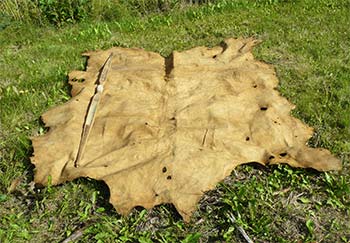
The successfully brain-tanned and smoked moose hibernate. A longbow seen on the left has been included for scale. The bow is 66 inches long. The final step will be to sew up all of the holes in the finished hibernate.
For most of human history, the skins of harvested big-game animals were not discarded past hunters. As a product of the hunt, skins were simply as essential to the survival of northern hunting cultures equally were an animal'south meat, fat, and organs. The hibernate was saved and processed into indispensable items: rawhide rope and cord, tanned skin for clothing, gloves, footwear, bags, pouches, quivers, blankets, shelter covers and much more. While information technology is safe to say that most behave skins are retained by hunters who harvest them today (and sometimes mountain goat and Dall sheep skins too) information technology is too safe to say that the skins of most of the moose and caribou harvested by Alaska hunters are not retained simply are discarded in the field.
This is all for very applied reasons. Getting the skin from a large game fauna out of the field and properly processing it for safe storage adds a lot of time and work to the priority chore of packing out meat, caring for its quality, processing it, and getting it put away in the pantry. Every bit rational choices, I've left behind more than than a few caribou skins and a few moose skins in the field, and a sheep cape in one case too. It is just what I had to do. I've packed a few very heavy, fat-laden, deport skins out of the field. The get-go time I did that when I got the pack on my shoulders my immediate reaction was "I don't think this is possible, can't practice it." But with more and more than steps I got used to it and have since packed a few caribou, moose, and deer skins out of the field as well.
Hide retention is a regulation for many Alaska behave hunts and is even a legal requirement for one Alaska moose hunt, CM300, the Copper Basin Community Subsistence Harvest hunt in GMUs eleven, 13, and a portion of 12. While I know there definitely are a few Alaskans effectually who keep their moose and caribou hides and turn them into usable products, the fine art of self-tanning big skins has largely been lost in Alaska today.
Over the last three years, as the section's Division of Subsistence contact for public inquiries regarding the Community Subsistence Harvest hunts (CSH), I accept received several phone calls from participating CSH hunters request about moose hides. Some of these hunters are not sure what to practice with the moose skin once they become information technology out of the field. My answer is that there are a few simple steps that must exist accomplished to commencement preserve the hide and that from there; many worthwhile things can exist done with the moose pare.
The simplest thing you lot tin do, if y'all are able and willing to take on the expense, is drop your hide off with a taxidermist and pay them to practise all the prep-work and so transport it off to a tannery. This is what happens with virtually acquit hides, just a bear hunter tin can save themselves a lot of money if they are least willing to complete the preparation themselves before sending the skin off to a tannery. Similarly, a moose or caribou pare tin can be dwelling-prepped and and so sent to a tannery, or fifty-fifty simply kept and used as rawhide for a multitude of things. Or, if you are willing to put in the time and attempt, you tin tan the peel of a moose, deer, or caribou yourself and be rewarded with beautiful soft buckskin, which is a large-game trophy in itself, for both the material and experiential rewards tanning provides.
I successfully taught myself how to brain-tan deerskins a decade agone. Yes, "brain-tanning," which ways that you are using an beast'due south brain to soften the skin into buckskin. For those interested in keeping their harvested skins and turning them into an astonishing product, and particularly for the benefit of those CM300 moose hunters who are required by regulation to retain the hides of harvested moose, I am going to explain how that process works. These instructions tin utilise to tanning the skin of virtually whatsoever big-game ungulate or bovid. Over the last several years I perfected them for caribou skins and this year I successfully completed the journey of encephalon-tanning a total size moose hide.
A moose chase prequel
The story of this particular moose hide begins in tardily-November 2011. I had spent nigh all my free time during that month wandering around on foot through sections of the Fairbanks Direction Area (FMA) clutching a handmade Osage orange Maclura pomifera longbow hoping to get an opportunity to take a curt range shot at a moose. Information technology was tardily in the season, the air temperatures had been hovering betwixt the teens and the single digits, and the spirits offered me a needed approving, a dusting of fresh snow on the ground. I walked from my cabin down a trail into the forest in search of fresh moose tracks. Moose are abundant in this expanse and it wasn't long before I encountered fresh tracks crossing the trail. I so cautiously and quietly began an almost day-long journeying tracking and and so getting into position to take a 25 g arrow shot at this moose. It was nearly nighttime past the fourth dimension I maneuvered my style by slowly crouching and crawling undetected through frozen muskeg to within this comfortable longbow range. I thought information technology might never happen, but but at my concluding moment of acceptable shooting light, the browsing moose, which had been moving in and out of the open up spaces between the brush, finally stopped in a immigration and turned broadside.
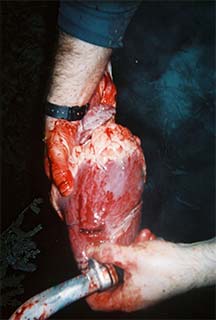
Effigy i. The heart of a moose harvested with a longbow past the writer in 2011. The horizontal cutting made by the arrowhead entering the middle tin can be seen in the photo, just in a higher place the author'south left thumb.
I had been diligently shooting practise arrows virtually every twenty-four hour period for two months prior, in preparation for this moment. Depict, aim, release-smack. The sound of the pointer's impact and shot placement looked proficient, but the moose did not hang out and only offer itself to me. Rather, information technology blasted into the adjacent bandbox forest and the flashing sight of its brown skin gave way to the sounds of crashing tree branches and sticks, then silence. I knew from previous archery experience non to give chase, but instead, after putting an arrow in an fauna, to wait for a while earlier resuming my tracking. I called some friends to help and an hour subsequently, in the cold darkness, we returned to the site-last-seen and picked up the trail. Ten yards into the wood and at that place was a massive claret pile, so the blood-covered fletched-end of my pointer missing its broadhead terminate, which had mysteriously snapped off, was found tangled in the branches of a dwarf birch shrub. Fifteen more yards of splattered blood patches and in that location it lay; moose down.
In the cold Fairbanks night we proceeded to do our diligent butchering. I couldn't believe my eyes when I got to the eye and plant a perfect broadhead arrow point cut going right through it. "That'southward some good shootin', boy," said 1 of my friend'due south in congratulations (later I would find that, later on traveling through the center, the broadhead stuck into the moose's opposing upper front end leg bone and was snapped off from the force of the moose's terminal run). My buddies and I proceeded to spend most of the dark packing out all the meat. The next day I walked back in to the kill site and packed out the moose's hide, which was just about as heavy as i of the hindquarters.
Forgive me for getting sidetracked. This is supposed to be an article most how to brain-tan a moose skin, non a hunting story. Only good hunting stories take e'er motivated and inspired me to go out on the land and to do a adept job at taking care of my harvests, so I hope this story will become some people fired up for good hunting and salve practices during this coming moose flavour!
Skinning and saving brains
If you desire to tan your own hibernate, the first thing to call up about is doing a careful, non-rushed, chore skinning your kill. The more than holes in the skin, the more work you will take in the stop. But most often there will inevitably be some holes so do not despair as these tin can all be sewn up later.
The second most of import matter in the field is to brand sure you do non forget to retain the animal's brains. I won't go likewise deep into the science on this hither, merely the gist is that the lipid breakdown of animal brains provides wild nature's perfect solution for penetrating and expanding the micro-fibers of peel and holding them open enough for the hide to remain soft and flexible without turning hard again (more on this later). I am non sure exactly how, only somehow hunter-gatherers the world over figured this out eons ago. The long told saying is that "every fauna has enough brains to tan its own skin." This fundamental cognition is a core-attribute of our human legacy; without it we would probably have never been able to survive long-term in northern environments.
Skulls from Paleolithic archaeological sites have been institute with the skull plates broken open, and it is surmised that this was done for the extraction of the brains for tanning purposes. You lot tin get most this in two different ways. The easiest mode to extract the brains is to remove the skull plate with a saw and scoop the brains out from the peak. I always put them in a carve up purse and non in a meat pocketbook, of course. Unremarkably I go on a few extra small Ziplocs in my hunting pack just in case I need them. While in that location are also accounts of Native Americans purposely fermenting the brains they saved for tanning, yous practise not demand to do this. If I am going to be in the field for a while with meat hanging I notice a apartment stone to spread the brains out on and allow them dry a footling bit, with airflow they volition develop a casing just like will hanging meat. Native Americans likewise used to preserve brains in this manner, like niggling dried hamburger patties (of class you volition want to be mindful of birds and other critters if you exercise this). If you've got yourself a real trophy set of antlers and are planning to do a European mount you plainly do not want to saw off the skull plate. In this case you tin extract the brains from the underside of the skull past creating an enlarged opening with a light saw at the extended end of the foramen magnum.
While brains are like shooting fish in a barrel to pack out large hides are usually non. Last yr I packed a friend's full bison hide a trivial less than ii miles. Earlier that day I had carried a bison hindquarter the aforementioned distance which seemed to accept been lighter than the hibernate! The aforementioned can be said for chocolate-brown deport hides and moose hides. Unless you lot can pull an ATV, boat, or airplane correct up to your moose kill, y'all will demand to carry the hide at least some altitude if yous plan to relieve information technology. And then it is good to pre-establish the mindset that you will have this extra load to deal with. You also need to be comfortable with the fact that in one case you have the hibernate out of the field your piece of work volition really but begin (later on you take taken proper care of your meat of course).
The thing that makes tanning big skins the near achievable is that working chop-chop, straight to completion is unnecessary, and instead it can be done in stages, making it relaxing and without pressure level. When you return from the field with your pare you can either mankind information technology right away (make clean the 'skin side' of ALL remaining flesh and fat), or if you have the freezer space you can throw information technology in the freezer until you have fourth dimension to exercise the fleshing. Yous'll need to do one or the other in a timely mode; otherwise your skin volition get bad. Depending on how you lot work and prior experience, it volition take well-nigh iii-4 hours (or perhaps more) to properly mankind a moose skin. After processing an entire moose, virtually people do not desire to jump straight into fleshing the hide. The easier thing is to freeze it then set information technology bated for a 24-hour interval when you can focus solely on fleshing.
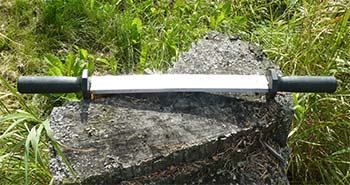
Figure 2. A steel hide scraper which can exist purchased online or at some sporting goods stores.
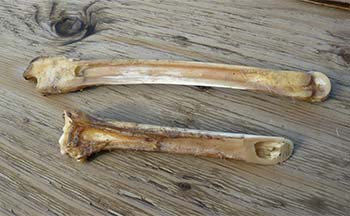
Figure three. Two different types of bone hide scrapers made past the author. Both the peel and the bone used to flesh and de-pilus it came from the same brute. The bottom tool is the 'chopper' used by the author to flesh and de-hair the moose hide. The top tool is fabricated from a separate bone and used as depict-pocketknife style scraper (see below).
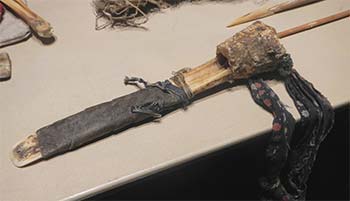
Effigy 4. A traditional Gwich'in moose hide scraper made from moose bone, from the drove of Paul Williams Jr., Beaver Alaska.
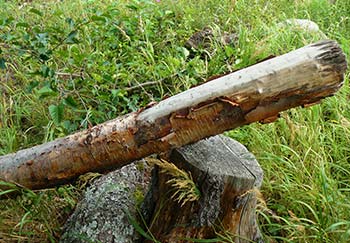
Figure five. A downward hibernate fleshing beam sometimes used by the author, made from birch. The upper section of the log has been stripped of its bark and slightly smoothed out with an axe. This is the surface on which the hide will be scraped.
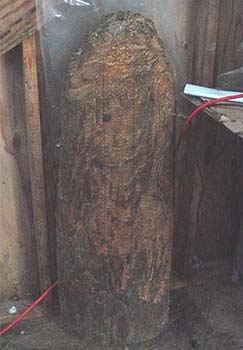
Effigy 6. An upright hibernate fleshing beam fabricated from a spruce tree by Sugpiaq people, Chignik Lake, Alaska. This log would be propped up against some other tree with the hibernate draped over it. Notation that the entire upper surface has been smoothed over with an axe. The author used a similar mode fleshing axle to flesh and de-hair his moose hide.
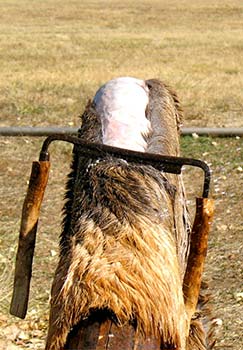
Figure 8. A downwardly hibernate fleshing axle and metal hibernate scraper beingness used to remove the pilus from an elk peel. Here, the pure white color where the hair has been removed shows that the scraper has done a thorough job of removing the epidermis.
Fleshing the hide
If you froze your skin you lot volition want to thaw it out over again earlier fleshing. You are going to remove the remaining meat and fat with a fleshing tool. You lot can buy a hide flesher online and also even at some sporting appurtenances stores in the trapping section. These work basically like drawknives, simply you lot are pushing downwardly and away, rather than pulling towards you (Figure 2). I have ofttimes de-fleshed with a very traditional bone tool, fabricated from the rear cannon bone (a leg bone) of whatever fauna I am working with. These types of scrapers have been institute in 12,000 twelvemonth old Clovis sites and thus have been in use for at to the lowest degree thousands of years (Figure iii). They are very common Alaska Native artifacts and are even still used by Gwich'in people in Beaver and Arctic Hamlet, made from moose or caribou basic (Figure 4). Using this type of ancient tool for removing both the flesh and hair on a skin can exist almost as efficient every bit using the metal tool and is very rewarding.
Fleshing is best done on a beam. Today people oft brand fleshing beams with a rounded off 12x2 inch board with the upper end raised upward to waist loftier by a support. With these types of beams ane usually uses a metallic fleshing tool and pushes off the meat and fat in a downward motion starting from waist high. Traditionally native people removed the bark from a polish log with minimal knots to make a fleshing axle. A proficient birch log about 6 feet long and 15-20 inches in diameter works well for this (Figures 5 and half-dozen). This can be propped up on a tree stump. Use an axe to chop out a divot in the stump that stabilizes the log. Y'all also will want to chop a make clean circular edge on the top of the log and then as non to damage the skin while working it. The edge of the log that is propped should be askew flat with an axe. In that location is besides a Native American tool made from a split tibia which tin be used just as a metal fleshing tool to push away meat and fat (See Effigy 3).
If you choose to utilize a bone tool then I recommend the cannon bone tool. Rather than pushing away meat and fatty, this tool scrapes information technology off clean with a chopping motion. To use this method your fleshing beam is propped up head high, against a tree or a wall, and you stand facing it and chop down. Here the weight of the log holds the edge of the hide in place against the tree (or wall). For both of these methods, you lot will need to constantly move the skin effectually and focus on working the small section on top of the rounded surface, scraping approximately ten inch 10 10 inch sections at a fourth dimension. Scrape until clean and echo and and so on until the hide is entirely fleshed. It will take some fourth dimension, and it will feel like work. Some sections might leave you confused as to whether there are withal pieces of stubborn fat remaining or not. If information technology is stringy and/or blood colored cloth that does not hands come off it is ordinarily membrane. Simply leave those sections for now.
Once fleshing is washed y'all take passed an important threshold. For ane, the hide will be a lot lighter and easier to store. Theoretically you could merely let it dry at this point and it will no longer rot, but it would demand to be laid out overnice and apartment or hung up on a axle and not be exposed to rain or moisture. Oftentimes people common salt their hides at this stage. Adding a layer of salt to the peel absorbs any remaining oil and wet and preserves the skin. If y'all are sending your peel off to a tannery, once fleshed, you just need to common salt it and permit it dry thoroughly, fold it upwards, and send it off (this gets more complicated with capes and animals with claws). If y'all only wanted rudimentary rawhide with hair on it y'all could besides finish here, only even if y'all wanted a rawhide skin with pilus intact for a wall-hanging you're better off stretching it get-go and allowing it dry that style, then it volition be overnice and flat when dry (I'll explain stretching in a moment). Merely if you want to make buckskin the adjacent thing you are going to do is to remove the pilus from the 'hair-side' of the pare (I'll talk a little bit virtually brain-tanning with the hair beneath as well).
Hair removal
Hair-removal likewise takes fourth dimension and feels like work. Due to time constraints, only with deer practice I normally both flesh and de-hair a hide in the same day. To make hair-removal easiest you are going to soak the hide for a mean solar day or so. The idea is to get the hair follicles to begin slightly rotting and then that they will loosen, but if you soak information technology likewise long you tin take chances rotting the hibernate itself. A thick moose skin tin can soak for a few days or more, but a deer should not be soaked for much more than a day or 2. Small skins can exist soaked in a bucket; big skins will exist soaked in a larger container, such as a 30 gallon trash can. The old way was simply to place the skin in a river or lake weighted downwards by rocks. If you salted and dried your hibernate you volition need to re-hydrate information technology. Just make full your trash tin with h2o and start stuffing the skin in, it volition automatically rehydrate. Rather than dry my skins after I mankind them, I frequently fold them up and put them back in the freezer while notwithstanding wet. And then when I want to remove the pilus I merely thaw it out and throw it in the h2o already wet. Once the hide soaks long enough to loosen the hair, hair-removal is washed the verbal same way as described higher up for fleshing. You can either use the cannon bone tool and chop downwards or the metal fleshing tool and push away. The hair will come up off in behemothic strips (Figure 8). You will frequently see a black colored layer coming off with the hair in big clumps. This is the epidermis and must be thoroughly removed for brain-tanning. The epidermis tin can often exist stubborn. Some sections will stay black in color even though the hair is gone. The cannon bone tool works well for going back over these sections. It will chop them away, sometimes in long black strips. Although user-friendly if it happens, do non worry besides much about getting all of the epidermis off right away. The first priority is to remove all of the hair, exactly equally described above for flesh and fat removal.
What I have been describing thus far is the 'wet-scrape' method of hide tanning. There is also a 'dry-scrape' method where the final work on both the skin side and hair side is done when the hibernate is dry out and stretched out on a rack. For big hides, I unremarkably use a combination of wet and dry out scraping. I exercise all of my basic prep-piece of work while the hide is wet and I practise my fine tuning prep-work while the hide is stretched and stale on a rack. If just moisture-scraping a pocket-size hide, once you lot get all the epidermis off you can either dry out the hide for storage and choice upwardly the piece of work over again afterward or you tin go straight to tanning (this will be described below). If, after removing the hair from a wet pare, yous do not have time to rack the skin, y'all can either throw it back in the freezer or let it dry, but to stretch it out on a rack you will need to rehydrate the skin again.
Before talking virtually racking your skin, I want to break and make clear that all of this can exist done in stages, and each major task can exist spread out over time every bit it becomes user-friendly for you. For instance, I put my moose skin in a freezer un-fleshed two days afterwards I killed the moose. A few months later I pulled it out and fleshed it and so put information technology dorsum in the freezer and the next summer I de-haired it. Then, a few weeks after that, I rehydrated it and racked it.
Racking the skin and lacing the hibernate
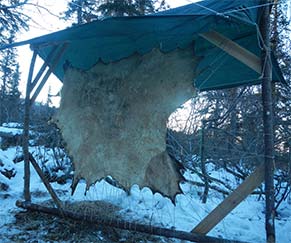
Figure 9. A caribou skin stretched on a rack made from spruce poles lashed together with rope. Here the author used chip 2x1 inch boards as cross-stabilizers. Annotation the tarp shelter used to protect the hide from snowfall or rain.
To rack your skin yous are going to need to make a frame, the frame is rectangular in shape and needs to exist large enough and so that the hide volition stretch to total capacity; 10 feet x8 feet is a skilful size for a moose pare, but you will need to mensurate it out because each hide is dissimilar and you lot exercise not want the frame to be too big either. Frames are nearly often made from 2x4s, held together by nails or wood screws. Traditionally, frames were made from raw woods, tree trunks, or large limbs measured to fit and lashed together with bark or strips of rawhide (Figure ix). Either of these types of frames should have stabilizing diagonal cross-beams on each corner. If yous do not use these, your frame volition twist when y'all stretch the cord. I accept made frames with both raw spruce poles and birch tree trunks lashed with heavy cord and they worked simply too, just milled lumber is ofttimes more user-friendly to piece of work with. Once your frame is built and your hide is ready yous will also need a bunch of high-quality cord.
Next you lot are going to put holes in the hide, through which to string the string all the manner around the circumference of the skin. For most areas, a hole every 8-10 inches works fine, but around corners on the legs or looser spots you might need to make a hole every iv inches. The pigsty only needs to be an inch or a fleck less from the edge and can be made with an awl or a knife. If you lot are using a knife, put a piece of 2x4 on the other side to finish the knife from slipping and making too large of a pigsty. When you stretch the hide some of the thinner holes might break. Its ok, information technology happens, simply endeavour to minimize it. If you lot have laced the hide a long means and a hole in the middle of the lacing breaks then you have to go all the style back to that hole, make a new one, and start lacing over again.
Once you have all your holes cutting it is time to lace the pare onto the frame. Lacing a hibernate to a frame takes some time. I always lace the head and tail ends first then lace the sides last. At first, lace the hide semi-taut but not too tight. Once all the laces are in you lot can judge where to tighten and where to loosen your knots so as to get the hide centered in the frame as best as possible. It is a flake ho-hum to get this perfect, and so exercise not worry virtually it likewise much, but practice your best. Once y'all accept it set as you run across fit then tighten all the cords and stretch the hibernate as tight equally it volition get. A big-game hide stretched on a rack is a beautiful thing. Take a rest and admire your work. Information technology will take a solar day or two to dry out.
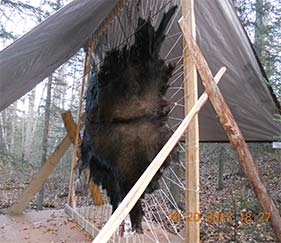
Figure ten. A moose skin with the hair on stretched on a rack made from milled lumber. The tarp system protects the skin from snow and rain.
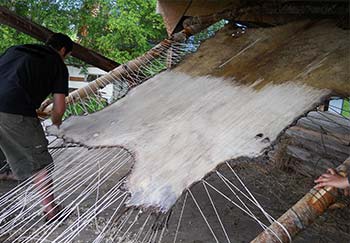
Figure eleven. The author using a dry out-scraper to remove the epidermis from the hair side of a moose skin. This is how it needs to wait earlier tanning. The epidermis has not been scraped from the top portion of the skin withal. The frame pictured here was made from birch trees and lashed together with rope.
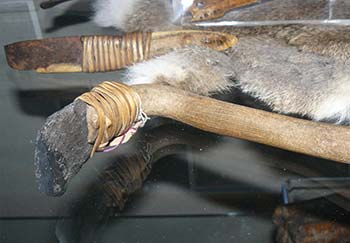
Figure 12. A traditional Alaska Native dry-scraper displayed in the Sheldon Jackson museum in Sitka, Alaska. The bract of knapped stone has been hafted to the antler with rawhide cord, or 'babiche'.
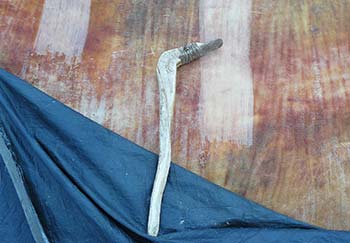
Effigy 13. The author's flint bladed dry-scraper. The bract is hafted with deer rawhide cord to the split edge of a moose antler paddle. In the photo the skin side of a bison hide is beingness worked with the stone dry out-scraper.
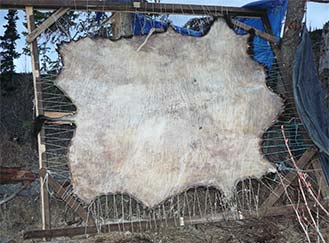
Figure 14. A bison hide with hair intact stretched on a frame. The skin side of this hide is gear up to brain. The stone and antler scraping tool used to complete the chore can exist seen hanging in the middle left of the frame. Note that the tail was stretched using a pocket-sized chip of plywood and some finishing nails.
Dry scraping
A dried hide on rack tin be stored indefinitely, as long as yous accept a place where it will stay dry (Effigy x). I have kept mine propped upward against trees covered by tarps and a garage will work every bit well. To work a stale hide stretched on a frame you are going to need a new tool – a dry-scraper. These expect like an adze and are oft made from the end of a rounded, beveled, sharpened file fastened to a wooden handle. Dry-scraping fine-tunes preparation of both the peel and hair side of a hibernate. On the peel side, dry-scraping allows one to remove stubborn sections of membrane. On the hair side, dry-scraping easily removes all remaining epidermis (Figure eleven). Dry out-scraping likewise facilitates proper scraping and cleaning of the edges on both sides of the hide. It does a corking chore of further opening upward the skin fibers to blot tanning solutions, and on thicker hides such as moose, a sharp dry-scraper allows i to evenly thin down thicker sections of skin, particularly the neck and backbone sections.
Many Native American dry-scrapers fabricated from knapped stone lashed with rawhide or bandbox root to antler, os, or woods, accept been collected and can be constitute in museums today (Figure 12). I have made a few different dry scrapers from metallic scraps simply most oft have used one that tin purchased online . Last year a friend and I successfully manufactured a traditional dry out-scraper from a knapped blade of flint lashed to the divide long edge of a moose antler paddle (Effigy 13). Nosotros have found that both flint and obsidian blades have the potential to outperform metallic blades for dry out-scraping hides, as metal blades easily dull and constantly need to be sharpened. Rock blades last longer without existence sharpened and exercise a bang-up job of removing membrane and epidermis from a stretched dry peel. Last twelvemonth, I was able to finish preparing the skin side of a stretched bison hide entirely with a stone/antler dry-scraper (Effigy fourteen).
I am not recommending that you likewise should gear up your skin with primitive tools; I am only sharing this for the purposes of inspiration. It really is a beautiful feeling to scrape clean a skin using stone in the same way our ancestors did for hundreds of thousands of years. Regardless of what type of tool you apply, the dry-scraping process is the aforementioned–you will use ane mitt to button the bract into the hide applying force per unit area as you push down on the scraper while stabilizing and pulling down with the handle (See Figure 11). Like anything, y'all will easily get the hang of it, finding the perfect edge, after a little bit of trial and error.
When you have a dried pare stretched on a rack, you can spend an unabridged day completing the scraping on one side, or y'all can spend 20 minutes or an hour once or twice a calendar month getting it done little-by-little. It is actually up to you. It becomes something like a giant painting on an easel that one works on from fourth dimension-to-time when they are feeling inspired or when just wanting some fourth dimension for quiet, meditative, self-reflection. You will scrape and scrape and each day you will see the progress. Yet, you practise not want to scrape too much as you might sparse the hide too much! You demand to eye this out carefully on the sparse spots of the skin. Often times you lot will know yous are done with a section when the surface becomes rough and looks a bit like suede in texture. Sometimes no matter how much y'all scrape a department you will non get that suede-like appearance and a glossy difficult texture will endure. Stop scraping here. The pare might exist stiffer in these sections but it will withal blot the brain solution. Lastly, once you are satisfied with the scraping on both sides (or just the skin side if you are attempting to tan with the hair on) you might want to run over the entire surface of the hibernate with rough grit sandpaper, just to open up the fibers a bit more.
Once you are satisfied with all your prep-piece of work the skin is ready to tan. As I mentioned higher up, one could do all this prep-piece of work and and then transport the skin off to a commercial tannery at this stage, which will relieve you more hard work. Past doing at least the pre-piece of work yourself you will save the coin you would have needed to pay a taxidermist to prepare your skin for the tannery. But here we are going to talk about brain-tanning your moose peel at dwelling.
Pre-Smoking
If you lot're working with a large skin such as moose information technology's a good idea to smoke your hibernate before tanning it. Pre-smoking my moose skin probable helped a lot with my tanning success. Wood fume penetrates the peel fibers and opens them upwardly to facilitate maximum absorption of the tanning solution y'all are going to apply. To fume the skin y'all tin place it in a fish smokehouse and smoke it just as you would your salmon, or you can make a teepee out of the skin by placing it on a wooden tri-pod frame and lighting a smudge burn underneath it. Smoke-wood tin can be obtained from dark-green-wood, rotten wood, or wood chips. Thoroughly smoke the entire surface of the skin on both sides. Exist very conscientious non to accidently lite your skin on fire.
Tanning
To brain-tan a moose skin I recommend you prepare aside ii days for defended work. But as chiefly, you lot will besides want to have some assist. Two dedicated and energetic people tin can exercise the job, but a family or group of friends turns the process into an enjoyable and meaningful community event. Of the two days you will need, just the 2d 24-hour interval requires full-time extended work. The first days work is intermittent and one can simultaneously relax or piece of work on other household chores while accomplishing the necessary tasks.
First, you want to remove your skin from the frame. De-lace it and set up bated the frame and the string, which you will be using again afterwards. Pull out the brains you are going to utilize from the freezer and let them thaw. Although, as mentioned to a higher place, i encephalon from each animal should suffice for tanning, for bigger skins I ordinarily try to utilize more if I take them, just every bit an insurance measure out. For example, for the moose skin I encephalon-tanned, I added an actress caribou brain to the solution (fifty-fifty when I exercise non keep the hide from a harvested animal I usually e'er go on the brains particularly for this purpose). Next you will demand to mash up the brains. Some people use a blender for this, I usually simply apply my fingers to smash the brains and knead them (it is upward to you if you wish to apply gloves for this and all that follows). When ready they should look like a grey/red colored strawberry milkshake. Every particle does not need to get mashed upward, just you should exercise equally thorough a job as possible. The mashing is best done in the pot y'all will be cooking your brains in. Add water to the pot. Around i liter of h2o volition work (for tanning with the fur on, you volition exist making more of a brain-paste, rather than a liquid and volition thus be using less h2o). Bring the brains and h2o to a light boil, stir, and let cool. Pour the brain liquid into a 30 gallon trashcan and add together a lilliputian chip more than cool h2o, only enough so that your hide will be submerged in the solution (the more than water the less potent the solution will be). Stuff your dried hibernate into the trashcan. In one case it contacts water information technology will immediately exist pliable and brainstorm absorbing the liquid. Mash the hibernate down and be sure it is fully immersed. If non add a little bit more water. Use large rocks to hold information technology downward so none of it floats upwards and becomes exposed. All of this can be washed in an 60 minutes's fourth dimension as an evening chore and, for moose, should be done about two days earlier the dedicated tanning work days you have planned. Leave the hide soaking in the brains for about 48 hours.
Now you lot are committed to completing the task. The next two stages demand to occur one after the other correct after the hide soaks, otherwise you will hazard the hide drying into rawhide again and so demand to attempt braining it all over. Commit to the work and do it correct the commencement fourth dimension, and you will be very happy with the result.
Wringing the peel
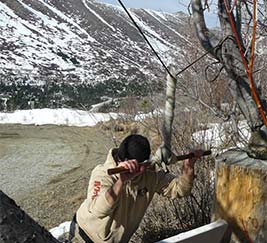
Figure 15. The author pulls down difficult on a caribou pare he is wringing and twisting with a stick. Hither a rope was used every bit a crossbeam for wringing, but for bigger hides such as moose its best to use a wooden pole.
Your get-go work day is for wringing the skin. Wringing stretches the pare, drains it of the liquid, and opens up the fibers to absorb more and more brain solution with each wringing session. For wringing yous will desire 4 to half dozen pieces of 12 inch long cord, a smooth, straight stick about 3 feet long and two inches in bore, and some type of cross beam, like a meat-hanging pole or rafter, about vii ft. off the ground (if you are working with moose). Place your "brain bucket" (trash can) under the cross axle and pull the hide out finding either the neck or tail end. Using the existing holes in this stop tie the hide up to the cross beam so that it is hanging affluent to the beam. Lift it out and permit the mass of excess brain solution drip back into the trashcan. Catch your wringing stick and curl and wrap the hanging terminate of the skin over and on-peak of itself and around the stick. You will need to play around with this to get information technology correct, simply when properly placed, the wrap volition hold itself as tension increases by twisting the stick for wringing. Once the stick is in identify you will continually twist the stick around in a circular motion getting the twist tighter and tighter. For moose its best to take to people working each end of the stick. As the twist tightens the liquid will pour out. Continue your trash can in the place and so information technology volition catch all this liquid considering you will need it for repeated wringing. Proceed twisting until the wrap is equally tight as possible. One person tin then pull down on the stick with all their body weight to provide a really potent stretch to the skin (Figure fifteen). Once you have virtually of the water out of the elevation end the bottom end will still be a piffling bit moisture as all of the liquid has run from the top down. To properly wring out this department of the skin you demand to untie the skin from the pole and re-tie it from the other finish and wring it that way besides. One time this is washed place the skin back in the brain solution and let it soak for about an hour, and and then come up back and repeat the wringing. I soaked and wrung my moose hide 5 times (a smaller pare can be wrung less). Each wringing session merely took most 15 minutes, and while the hide soaked betwixt each session I was able to both relax some and work on other chores. Later on the 5th wringing I just left the peel in the brains for another dark. After all this wringing and the final overnight soak, all of the skin fibers became very well saturated with the brain lipids necessary for adequate tanning.
The post-obit morning will be your well-nigh critical day. It has all come up down to this. A massive but final burst of diligent and committed physical effort, which, if not faltered, will plough you big-game skin into a existent authentically brain-tanned hunting trophy. For a large skin this work session volition exist an all-twenty-four hour period matter. Information technology took me and my very reliable and difficult-working partner most 12 hours to consummate the tanning of my moose hibernate.
Stretching and completing the tanning
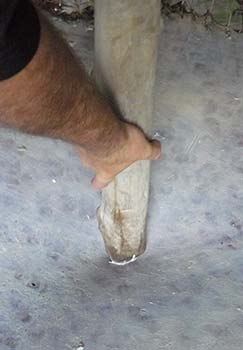
Figure sixteen. The author uses a blunt wooden bandbox pole to stretch a brained caribou hibernate on a rack. In this example, the hair side was not scraped and the peel was tanned with the pilus on. A brain-paste was rubbed into the skin and then the skin was stretched dry out using the spruce pole and other tools.
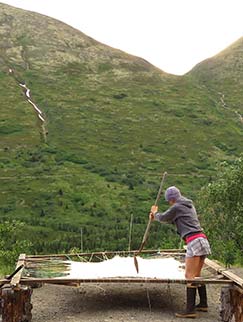
Effigy 17. The moose hide is worked with a shovel as information technology is propped upward on spruce rounds. The metal pole which was used equally a stretching tool is seen leaning against the left side of the frame.
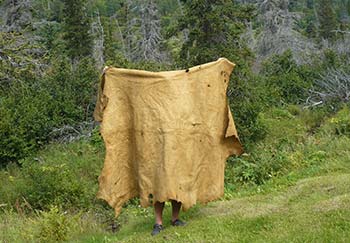
Effigy 18. The author stands with the successfully encephalon-tanned moose hibernate.
This is the nearly critical thing to remember on the day you tan your pare: it will need to exist thoroughly stretched, every single square inch of it, AS it dries. If you lot allow whatever function to dry without the fibers being fully worked and stretched it Volition dry back into hard rawhide, regardless of brain assimilation. The motto is: Stretch the Skin Dry. Information technology is a tedious and time consuming task, but and then are many things in life which ultimately terminate up being worthwhile for those who put in the endeavour.
On that final day of hard piece of work, we got up early in the morning had java and food and then got to it. First we pulled the pare from the liquid and did some other wringing, but this time very light, just to get the backlog h2o out only not so much every bit to allow any areas the chance to dry too quickly.
Small skins such as deer are best hand stretched and also can exist worked over a beam, a tight rope, or cable lariat. But a big pare is best stretched on a frame. Thus after our light wringing we set about re-lacing the pare back onto the frame. Once we had the wet skin all laced upward again we pulled it as tight as possible on all sides. And so, in lodge to facilitate our stretching procedure, nosotros propped the frame up on all 4 corners with cut bandbox log rounds, each approximately 2 feet tall. We moved hastily to get all of this done in guild to make certain we were stretching the skin as much as possible while it dried. But you certainly accept some time to do a proficient job re-framing the skin. There is leeway of an hour or fifty-fifty perhaps two for this part of the process.
In one case the pare is stretched on the frame information technology needs to exist worked in every direction and in whatsoever fashion possible. Some Alaskan readers are probably familiar with the famous "Eskimo Blanket Toss" where a giant split walrus skin is held by a group of people in a circle while a jumper is propelled up to thirty feet into the air past the movement of the blanket holders pulling in unison on the hide. It is very probable that mod trampolines ultimately evolved from such a practice where hunting peoples had become creative in the ways by which animal skins could be fairly stretched. I have heard stories about ethnic people bouncing children on skins as well - a dual purpose tactic for both children'southward play and tactful hide tanning. Even so, on this day we did not have a big group of people or pocket-size children available to assist us with our moose skin stretching job. Instead, we used a variety of paw tools. Traditionally Native American people used wooden poles, both precipitous and blunt on the ends, to press into the skins and provide a variety of different stretching pressure level (Figure 16). Eskimo people often used the edge of a tiresome ulu knife. We used two different bandbox poles and also used a shovel and metal pipe. We employed a diversity of motions to work the skin. Sometimes we pushed, other times we pressed hard and scraped, and other times we used force to pound on the skin (Effigy 17). The shovels and the metal pipe piece of work excellent as a duster to button out the excess water. We often pressed difficult in a downward motion and scraped the tools beyond the skin. Slowly the skin became drier, softer, and more and more than pliable. After taking a few curt breaks here and in that location and and then continuing to diligently piece of work the peel we reached a indicate where the skin was very close to dry, but not dry enough, and it seemed that no matter what we did it would not ever dry thoroughly in the time we had left to complete the chore.
Some of the caste of endeavour required is related to the conditions. If you are working outside and it is rainy, or inside and you practice non have enough airflow, the process will become difficult. However, you also could have trouble if yous are working outside when it is besides hot, equally and then the hide could dry out too fast. The day we tanned the moose peel was cloudy and a fleck absurd but also somewhat breezy. When the sun came out that mean solar day, we received our greatest skin drying aid from Mother Nature. Nonetheless, we even so could non consummate the tan until we moved into the business firm and started a burn down in the wood stove. Indoor tanning with the assistance of rut from a wood stove is a long practiced method of finishing a pare and it works brilliantly to help along the final stretching and drying process. We simply got the fire hot and pulled the hibernate dorsum and along beyond the oestrus for about an 60 minutes until it finally stale. When information technology did dry, it was as soft every bit could possibly exist for a home-tanned moose skin! It was 2am and after we admired our work and the accomplishment of a perfectly encephalon-tanned Alaska moose skin, I curled up in it like a blanket and fell asleep on the floor next to the wood stove.
Simply over five years subsequently this moose met my arrow I had finally finished the task of tanning its pare using its own leg bone equally a scraping tool and its own brain as the tanning agent (Figure 18). Although it took me five years, I stayed committed to the task and was able to accomplish it while maintaining a full-time job and dozens of other commitments because of the capability to consummate each step in stages, equally I have lain out in this commodity.
Smoking the skin afterward tanning
Two more steps remain earlier nosotros can call the job done. After you take completed your tanning, if you want a material that is more durable for outdoor wear, you will demand to thoroughly smoke your hide (if y'all pre-smoked your hide you will now be smoking it again). The reason why buckskin used in art, artifacts, jewelry, clothes etc. is ordinarily tan in color is considering it was smoked. Smoking the skin is said to waterproof it. As explained above, the smoke penetrates the fibers yous have separated with the brain lipids and the stretching and essentially seals them open. After your skin is tanned and then smoked, if information technology gets rained on or even submerged information technology will so dry soft. Sometimes you will see white buckskin. For example, there are white colored Native American buckskin dresses in museums. It is said that buckskin was normally non smoked for formalism wear or for any special item that would not be exposed to the outdoors. So it is up to you to fume your finished skin or not. The more than thoroughly you lot smoke the skin the darker the color will be and the more the durable it will be. Different woods also create different colors. You lot will take to experiment. I smoked my moose skin inside of my fish smokehouse using rotten cottonwood stumps (come across 'pre-smoking' above for more than on this).
Patching and un-framing
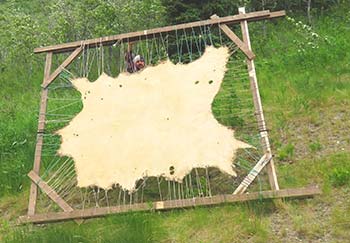
Effigy 19. The author displays the well-nigh stale and tanned moose skin. Moments afterwards the pare was cutting from the rack and brought indoors to exist finished adjacent to the heat of a woodstove. The many holes in this pare volition be sewed upwards after the hide is smoked.
Lastly, when the final stretching and drying is complete, there volition usually yet exist a few holes in the skin. Subsequently you end smoking the skin, sew together each of the holes with either artificial sinew or real sinew. I always use real sinew, which you can also obtain from any harvested mammal. As well, when you pull your hibernate from the frame for the final time you practise non desire to united nations-lace it. Instead y'all want to cut it off just inside from the lacing holes (Effigy 19). Not merely are all of those holes undesirable, the edge of a skin is hard to tan and ordinarily ends upwardly stiff, and so cut the peel off of the frame with a pocketknife (later on, you can unlace the long edge portion of peel and apply it to make rawhide rope and cord if you so desire). At present it is up to you what you will make with your tanned skin! Information technology is a whole lot of work, merely I tin attest that it is a very worthwhile feel.
Please write to james.vanlanen@alaska.gov if you lot take whatsoever questions nigh brain-tanning.
iwww.braintan.com sells the dry-scraping tool I use.
Source: https://www.adfg.alaska.gov/index.cfm?adfg=hunting.tanhide
Posted by: ambrosinoagagedly.blogspot.com

0 Response to "What If Raw Animal Hides Begins To Rot"
Post a Comment